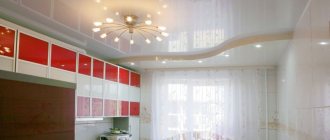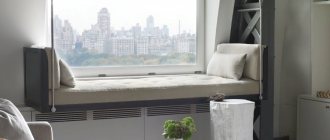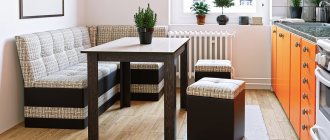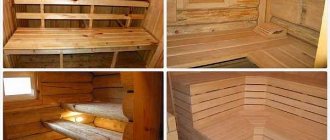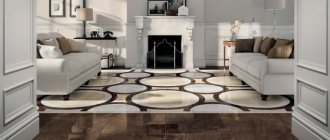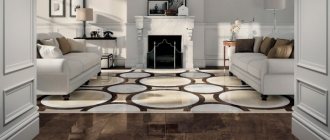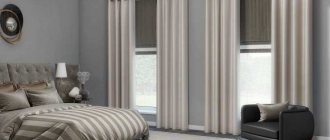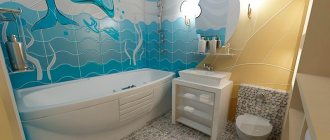Assortment of screens
The space available under the bathroom can be left unused or used as a place for storing various household items. It is covered with a screen consisting of a durable aluminum, steel or polymer frame and a panel that is fixed to it.
The range of these products is huge, especially for decoration. Models of different shapes and textures, plain and decorated with photo printing, are available for sale.
Depending on the design features, screens are made:
- sliding;
- stationary deaf;
- removable;
- with doors - hinged and hinged;
- with a service hatch;
- with shelves.
Their canvas is:
- solid;
- lattice.
As a result of installing a lattice-type screen under the bathtub under the plumbing, air exchange improves, and unpleasant odors and mold do not appear there.
Most factory-made models are equipped with adjustable legs. Thanks to their presence, a gap is formed between the floor covering and the lower edge of the screen, allowing a person to stand close to the bathtub. The standard length of the structure is 150 - 170 centimeters, and the height is 50 - 60 centimeters, but other standard sizes are also available in the range.
For the production of these products, materials that are highly water resistant are used. These include plastic, moisture-resistant plasterboard, plexiglass and MDF. Each type of product has both advantages and disadvantages that influence the choice. Many consumers prefer this economical option: installing a sliding plastic screen under the bathtub.
Depending on the material of manufacture, these products are:
- Plastic
. Among their advantages is a wide variety of colors and textures. Such products are easy to clean from various contaminants, they do not deform, and retain their original appearance for a long time. There is nothing difficult in such a job as installing a plastic screen under the bathtub. The disadvantages include insufficient mechanical strength and instability to chemicals and abrasives. - Glass
. Plexiglas products look original and impressive. There are options available for sale in matte and mirror finishes, with painting, with a corrugated surface and other decor. The material is characterized by durability, strength, high resistance to abrasion and the influence of detergents. Disadvantages include high cost and heavy weight. Compared to plastic products, the process of installing a plexiglass screen under a bathroom is more complicated. - From MDF
. Such products have a wide selection of colors, affordable prices, and are easy to install. Screens made from this material are easy to clean from dirt, they do not require special care, and they will suit any style of room. But there are also disadvantages - a tendency to deformation, a short service life, a limited number of standard sizes. - From plasterboard
. The most popular option for making a screen with your own hands. Drywall can be easily adjusted to fit different sizes and shapes of plumbing fixtures. It is distinguished by its low weight and long-term operation. The work involved in installing a screen made of plasterboard sheets under the bathtub takes a lot of time and requires mandatory decorative finishing.
Before installing most models, it is necessary to assemble the frame along the perimeter of the bathtub. It is most often made from aluminum profiles and much less often from wooden blocks. Before installing a screen made of lightweight plastic for the bathtub, you do not need to make a frame, since it is attached directly to the side of the plumbing.
In some cases, the space is covered with brickwork, after which it is lined with mosaics or tiles. Experts recommend leaving an emergency hatch in such a wall for repairing communications in the event of an accident, so that you do not have to disassemble it. The design created in this way looks great and is reliable, but the workflow of how to install a screen under a bathtub is time-consuming and eliminates the use of space for household purposes.
What types of screens are there?
All screens are rigid structures with hinged or sliding panels on a frame. In most cases, they are installed on the outside of the bathtub. There is a wide selection of industrial models with different designs and design features. Different materials are used both for the manufacture of the frame and panels.
Differences in materials used
The frames are made of aluminum, steel or plastic. In home-made structures, metal profiles for plasterboard and wooden blocks are used. Plastic frames are less reliable than metal frames. If you do not arrange storage under the bathroom for small items that will be used several times a day, you can choose plastic. The doors in this case only provide access to communications.
Screen made of wooden blocks.
For the manufacture of panels there is a greater choice of materials:
- Plastic screens can have different textures and shades. They are easy to care for: dirt and soap scum can be removed without problems. Installation is simple, the material does not deform.
- Spectacular and unusual models are made from plexiglass. They have a matte or mirror surface, onto which painting or other decor is applied. The material is strong, durable, inert to detergents, and does not wash out.
- MDF panels are inexpensive and come in a variety of colors. Contaminants are easily removed from their surface; special care is not required. They fit organically into the interior.
- For home-made structures, in most cases, moisture-resistant plasterboard is used. It is easy to cut to size and give it the desired shape. Lasts for a long time.
Screens made of metal, acrylic or combined materials are less common.
A common homemade screen option is brickwork under the bathtub. It is covered with tiles, mosaics, and a technological hole is left for access to the siphon.
Brickwork under the bathtub.
Design differences
The frame and panels are the main parts of the product. They are available in 2 versions: solid and with doors that provide access to communications and items stored under the bathroom. Models with a beautiful design organically complement the interior if the design is in the same style or monochromatic.
Existing panel placement options:
- in the form of sliding doors;
- removable or hanging screens;
- blind stationary slabs;
- swing doors;
- with inspection hatches in fixed facades.
Sliding doors slide along tracks to reveal the space underneath the bathtub. The metal frame is more reliable for them. Such screens can be easily installed in small rooms - they are compact and do not take up free space.
Hinged doors are convenient to use, but when they are in the open position, they require additional space. For small rooms this is not the most suitable option. Before purchasing them, they take measurements to find out whether the door can be opened freely. Models are also produced whose doors do not open to the sides, but fold down. They have the same disadvantages.
Removable panels do not have a technical opening for inspecting communications. If necessary, they are dismantled. Used primarily with acrylic bathtubs.
Plastic sliding screen for the bathtub.
Solid screens are the most durable; their solid surface is more attractive than one divided by sections or doors. They provide more possibilities for design, but even plain ones, without decoration, look beautiful. Fixed parts have a longer service life.
A significant disadvantage of this type of screen is that it blocks access to communications. If necessary, the panel is removed to get to them. This takes a lot of time, which in an emergency can lead to flooding of the apartment and neighbors.
A fixed stationary screen with an inspection hole eliminates the need for dismantling. Access to pipes for repair is provided through an inspection door. Its small size does not allow you to arrange shelves under the bathroom for storing small items.
The surface of the screen is made not only solid, but also lattice. In the second case, air exchange under the bathtub improves, and the likelihood of mold and unpleasant odors is practically eliminated. The design of most industrial models includes adjustable legs. A gap is formed between the floor and the lower end of the panel, which allows you to comfortably stand next to the bathtub.
Screen selection nuances
Before installing the screen on the bathtub, you must purchase it in advance, carefully considering which model is best suited.
When making a choice, you need to take into account:
- appearance;
- durability;
- functionality;
- price;
- complexity of installation.
If the screen is attached under the bathtub to close unsightly communications, you can consider the option of installing simple removable or stationary products with a hidden hatch.
When the active use of the space available under the plumbing is planned, the home craftsman will need to figure out how to install a sliding screen with doors under the bathtub. This most convenient option is universal for bathrooms of any size. As for hinged doors, they are convenient to use exclusively in spacious bathrooms.
When starting work like assembling a screen for a bathtub, you need to prepare the fittings, but they must be made of corrosion-resistant materials, otherwise the product will soon lose its original attractive appearance. It should be taken into account that plastic components wear out quickly and are characterized by low strength.
In turn, parts made of galvanized steel retain their inherent qualities throughout the entire period of operation. When purchasing all the elements, you need to make sure that they are of high quality, have smooth door movement and a tight fit to the frame.
If the renovation of the bathroom is not completed, and it is impossible to find out the exact parameters of the product, the best solution would be to purchase models where it is possible to make adjustments. Their cost is higher, but there are no problems with how to attach the screen under the bathtub and make adjustments. It is advisable to select the best option after finishing is completed.
The decorative design of the structure must match the style of the bathroom in texture and color scheme. In small bathrooms, mirror products look advantageous, since their reflective surface expands the surrounding space.
The image on the front panel and photo printing must match the interior. For example, a screen with a floral print in a room decorated in a marine style will look out of place. An image of the inhabitants of the sea or waves is ideal.
When there are a lot of contrasting and bright elements in the bathroom, it is better to install a single-color screen and vice versa; for a bathroom decorated in soothing colors, a product with a large colorful pattern is well suited.
When making a choice before installing a screen under the bathtub, it is advisable to pay attention to the product manufacturer. The most popular models among consumers are TM OSM, Vannbok, MetaKam, as they are distinguished by the variety of materials and colors used.
How to install a factory screen under a bathtub
Before installing the screen under the bathtub, all repair work in the room is completed and utilities are connected. If the plumbing has already been used, the space under it is inspected, dust is removed, and the walls and flooring are checked for mold and damage.
There are a number of requirements regarding how to properly install a screen under a bathtub, especially when a solid model is to be installed. You should not leave dirt or defects under a plumbing fixture.
Before installation, the screen is unpacked and its contents are checked, which as standard should include:
- guides and racks made of aluminum;
- legs;
- panels with holes;
- plugs;
- handles plus fasteners;
- self-tapping screws;
- handles plus mounting screws;
- instructions for installing a screen under the bathtub.
Installation is carried out in a certain order:
- Both guides are placed on a flat surface parallel to each other with the grooves inward.
- Racks are placed across them on top and the mounting holes on the profiles are aligned.
- Insert self-tapping screws into them and tighten them lightly, ensuring the racks are fixed in the required position.
- The panels are inserted into the grooves of the guides and then the structure is adjusted in height, the self-tapping screws are tightened on the racks, and the ends of the guides are covered with plugs.
- Screws are placed in the holes of the panels and the handles are screwed on.
- If there is a pipeline on the side of the bathtub, measure the height and width of the indentation from the wall and make a cutout in the screen. Measure a certain distance on the guide profile, mark the cutting line with a marker and saw off the excess with a hacksaw for metal work. Next, cut a hole of the required size in the panel using a mounting knife.
- Before fixing the screen under the bathtub from the lower end, place the legs into the racks and lightly tighten them. Having lifted the structure, its upper edge is placed under the side of the plumbing and aligned relative to the vertical. Then the legs are twisted all the way so that the product is firmly in place.
If you need to cover both the front side and the end of a plumbing fixture, purchase a model with an end panel. In this case, the main frame and panels are assembled. Next, the ends of the guides are placed in the grooves of the corner profile and secured with self-tapping screws.
The end panel is fixed on the back side of the profile. The process of how to install a screen of this design correctly under a bathtub is carried out in the same way as in the case of a conventional product.
Installation of a purchased model on an acrylic bathtub is carried out in the same order if it has a rectangular shape. But often the design of plumbing. for example, made of acrylic, it has bizarre shapes and therefore it is not always possible to select a screen.
Some German manufacturers equip their hot tubs with it. The consumer can only install the screen under the acrylic bathtub according to the instructions, but this is an expensive option.
There is another easier installation method, but then the appearance of acrylic plumbing will suffer. To do this, before attaching the screen to the acrylic bathtub, drill holes in the side of the bowl and fix the product to it.
Installation of a purchased screen
When choosing a purchased sliding screen model, the following factors should be taken into account:
- functionality of the purchased product;
- its cost and service life;
- complexity of installation and design.
In cases where the screen is intended only to hide communications laid under the bathroom, you can get by with installing stationary hinged or removable panels equipped with a hidden hatch. The most versatile and easy-to-use option is a screen product with sliding doors, the installation of which will be discussed further.
Required tools and spare parts
Before installing the screen under the bathtub, you should worry about preparing the tool, which must include:
- hacksaws for wood, plastic or metal, used to fit ready-made screen blanks;
- a drill with an impact function or a hammer drill, necessary for punching mounting holes in the walls;
- a hammer and a set of screwdrivers, as well as a marking set (chalk, string, level).
In addition, special fasteners will be required to fix the frame elements (sometimes it is supplied with the purchased product). After this, you need to check the entire kit, which, in addition to the panels, should include ready-made racks and aluminum guides. In addition, it usually comes with plastic plugs, a set of hardware, handles with fasteners and instructions for installing the product. This should be used as a guide during the process of installing a purchased screen.
Assembly (fixation of parts)
According to the attached instructions, the installation of the screen structure is carried out in stages.
First, both guides are laid on a flat plane so that their grooves face inward. After this, racks are placed on top and across them, simultaneously aligning both mounting holes. Then the self-tapping screws supplied with the kit are lightly placed in these holes and tightened enough to secure the posts in the desired position.
Upon completion of fixing the frame, the sliding doors are carefully inserted into the grooves of the profiles, after which the entire structure is adjusted in height, and then the hardware on the racks is fully tightened and plugs are inserted into the ends. At the next stage of assembly, the handles are screwed to the doors, and the legs are inserted into the support posts and lightly screwed. After this, you should lift the entire assembled structure and place the top cut under the side of the bathtub, aligning its edges vertically
After this, you should lift the entire assembled structure and place the top cut under the side of the bathtub, aligning its edges vertically
At the next stage of assembly, the handles are screwed to the doors, and the legs are inserted into the support posts and lightly screwed. After this, you should lift the entire assembled structure and place the top cut under the side of the bathtub, aligning its edges vertically.
Upon completion of this operation, all that remains is to unscrew the legs until they stop, after which the assembled fence should be securely locked in place.
When assembling a structure with end walls, all these operations are repeated for each of the sides of the bath, after which all three elements are attached to the support posts using suitable hardware.
https://youtube.com/watch?v=u0M3t4gP2GA
